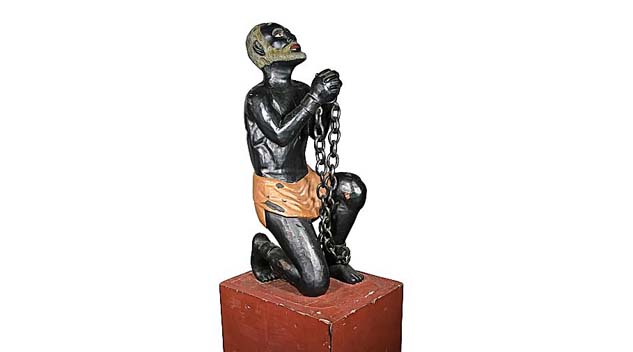#Slotin #Folk #ArtAfrican #American #Collection #Powerful #Overview #History #Antiques #Arts #Weekly
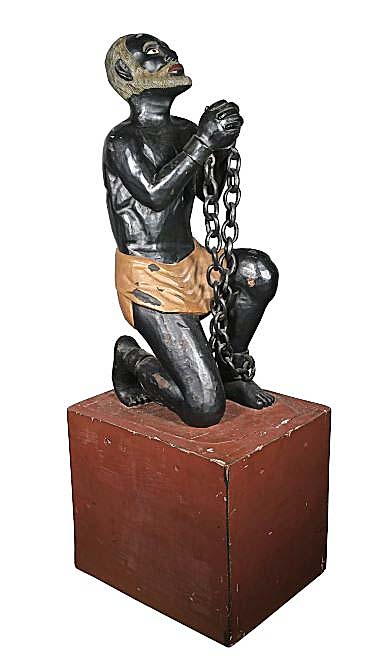
Top lot on day two and the overall sale, was an antique Anglo-American Abolitionist Society large trade sign that more than doubled its high estimate to sell for $10,000. The circa Nineteenth Century figure of a kneeling enslaved man was of carved and painted wood with gesso, 17½ inches wide by 57 inches high, including the base.
Review by W.A. Demers; Photos Courtesy Slotin Folk Art
BUFORD, GA. — An antique Anglo-American Abolitionist Society large trade sign more than doubled its high estimate to sell for $10,000 at Slotin Folk Art’s February 11 auction. The circa Nineteenth Century figure of a kneeling enslaved man was of carved and painted wood with gesso, 17½ inches wide by 57 inches high, including the base. Unsigned, the figure resembled the famous one created by Josiah Wedgwood depicted on the seal for the Society for the Abolition of the Slave Trade, a British Abolition group formed in 1787, which included the motto, “Am I Not A Man And A Brother?”
The 286-lot sale on the second day of the February 10-11 event featured the Richard Harris African American Experience Collection that included objects and ephemera depicting and documenting slavery, the Civil War, KKK/lynching, the Civil Rights Movement, Black Power to today’s media headlines of Hands Up/ Black Lives Matter. Also included was an important collection of African American self-taught art. The uniqueness of the collection was that it was not a “trophy collection” but rather a very powerful overview of the true American History that cannot be erased.
Stated Amy Slotin, co-owner of the firm, “Some of these objects are so historically significant that many were purchased by museums and institutions, which is a rarity for our auctions.
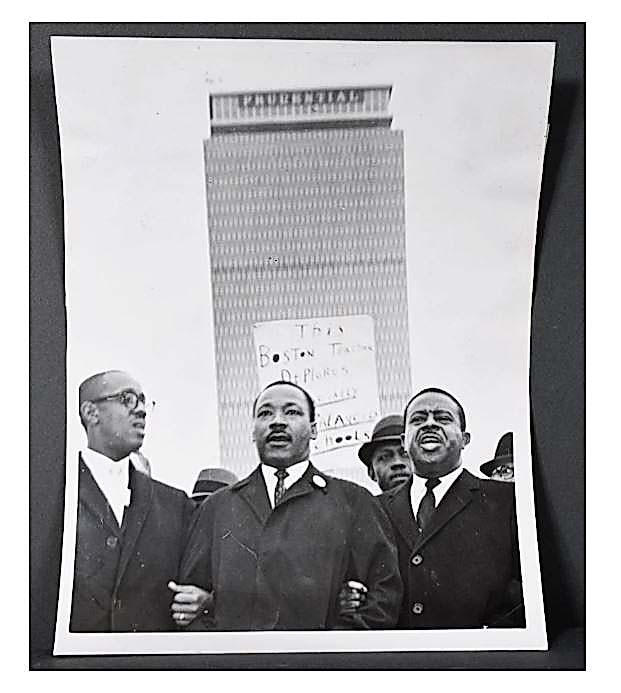
Eight black and white wire press photos of Dr Martin Luther King Jr crossed the block at $1,750.
“The last time we sold a significant collection of historical objects was when we auctioned off the entire contents of the Old Slave Mart in Charleston, S.C. For that auction, the Smithsonian sent down a half a dozen curators to study the objects, armed with a huge budget to purchase pieces for their collection. One curator in particular pored over the documents and cried when she saw the actual step that enslaved men, women and children all had to step on to enter the auction before being sold.
“With Richard Harris’ carefully curator collection, I had the same sense of being surrounded by history — painful as it is.
“Feeling the enormous weight of the shackles, or seeing the segregation signs from our own town, or seeing that the entries to the Klan membership dues basically had every single white man in the town, including the ministers, seeing the photos and broadsides for the free breakfast program put on the Black Panthers (knowing that J. Edgar Hoover himself acknowledged that it was the Free Breakfast Program — not guns in the hands of Black Panthers — that posed the greatest internal threat to National Security), or the amazing collections of press photos deaccessioned from struggling newspapers to pay the bills, including images of Martin Luther King Jr and Ralph David Abernathy in jail, a colored troops survival reunion flag from 1915; Civil Rights posters of the day and so many more unbelievable objects from our history. The collection in its entirety profoundly affected me. In an era when some politicians are trying to censor and alter history — even recent history — these objects refuse to let us forget.”
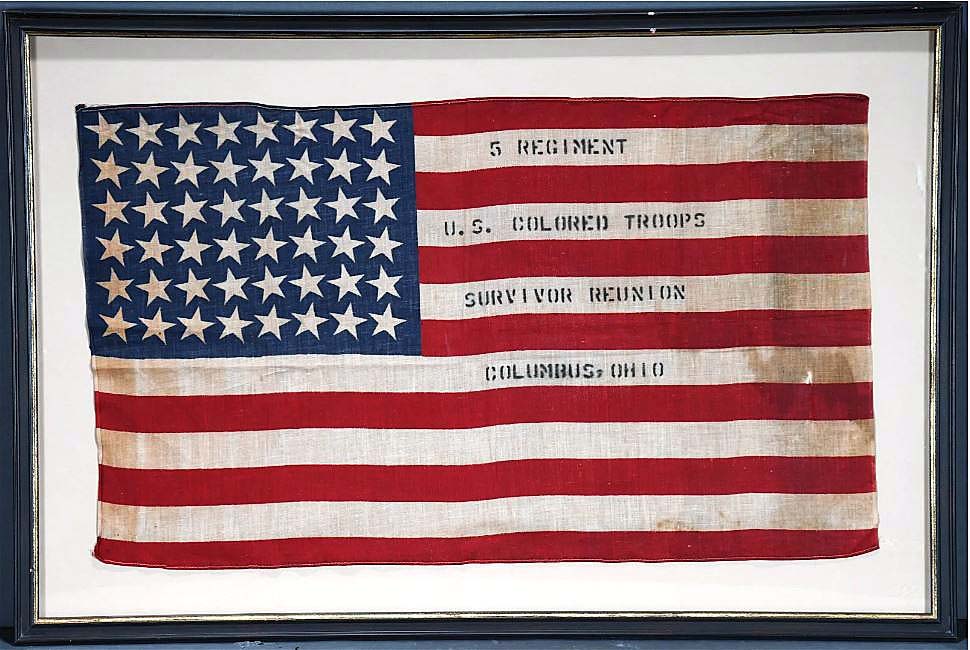
A 48-star national flag, Fifth Regiment US Colored Troops survivor reunion flag made $2,875.
On February 10 in an online-only auction that ran without reserves, Slotin featured Southern folk pottery and contemporary quilts.
The 698-lots over the two days totaled $342,531. In addition to the Harris collection, the sale was also rich in Southern pottery. Leading the category was a rare Lanier Meaders face jug with a double row of teeth that brought $2,250. Of Southern American potters Quillan Lanier Meaders (1917-1998) may be considered the master of the form. In fact, he was part of a pottery dynasty. His grandfather, John Milton Meaders, launched the family’s pottery business in Mossy Creek, Ga., in 1893, with his five sons as employees. Lanier, his grandson, carried the family’s traditional ceramic craftsmanship forward, typically crafting pieces in earth-brown, olive-green and rust-gray that he had favored while apprenticing to his father. Those same colors are present in the face jugs that Lanier Meaders and his fellow crafters produced, taking a fully functional piece that had the practical purpose of holding and pouring liquid into a form that some scholars believe doubled as a form of self-identification or, as some folklorists suggest, were spiritual talismans buried outside of front and back doors to scare spirits away.
Michael Gates’ 5-gallon Blue Devil face jug grave guardian, 2003, which went out at $2,125, lends credence to another less practical use for face jugs — grave markers that would be placed atop burial sites surrounded with the possessions of the deceased. Stamped, dated and titled, 24 inches high, Gates’ jug was deemed to be in mint condition.
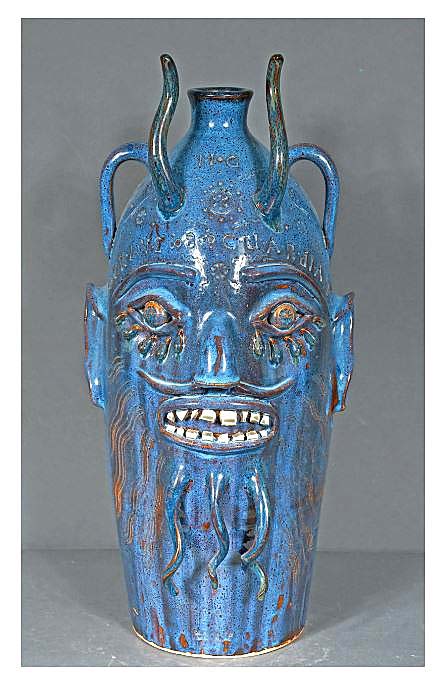
Michael Gates’ 5-gallon Blue Devil face jug grave guardian attracted $2,125.
Chester Hewell’s jug decorated with a farm scene, 1995, was one of the non-face jugs bringing notable results. Estimated $300/500, signed and dated and in mint condition, the 14-inch-high jug commanded $2,000.
There was Carl Block’s grotesque “To Each Monkey” face jug, 6 inches high, with a grinning row of Chicklet-like teeth painted in various stages of decay, which beat its low estimate by 10 times, going out at $1,100,
Another work from the Meaders combine, this one by Edwin Meaders, was a figural piece, a dark blue rooster, done in 1992. It was signed and dated, standing 16 inches high and strutted to $1,625, twice its high estimate.
There was Carl Block’s grotesque “To Each Monkey” face jug, a 6-inch-high with a grinning row of Chicklet-like teeth painted in various stages of decay, which beat its low estimate by more than 10 times, going out at $1,375, while Roger Corn’s “Uncle Sam,” 2001, signed, dated and titled, gave the dark, mustachioed, face a top hat topping, itself providing a flat surface for a wheeled cannon. It sold for $1,250.
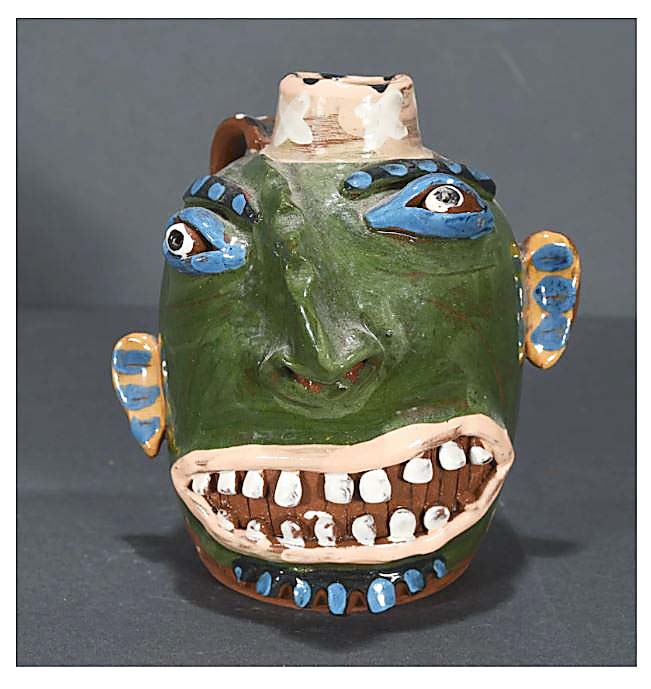
Carl Block’s grotesque “To Each Monkey” face jug, 6 inches high, with a grinning row of Chicklet-like teeth painted in various stages of decay, beat its low estimate by more than 10 times, going out at $1,375.
More traditional pottery crocks and jugs were presented by Michael and Melvin Crocker in the form of a 5-gallon crock that had 360-degree decoration, $1,375; a Michael Bayne “Adam and Eve” decorated jug, also at $1,375; and a piece by Ron Meyers that combined a Southern pottery urn form with fanciful Rubenesque nudes, which sold for $1,188.
Contemporary quilts were part of the mix on the first day. Fetching $4,375 was an “Affairs of the Heart” quilt by Aie Rossman. Kaleidoscopic in design with colorful applique blocks and based on Burmese temple murals, the 2004 textile, 102 inches square, was awarded a first place ribbon at AQS International Quilt Show in Nashville, Tenn., as well as being exhibited at the Folk Art Center in Asheville, N.C., in 2014, as part of “Eyecatchers: The Hunter Collection” from the private collection of Barbara and Robert Hunter and the National Quilt Museum in Paducah, Ky., in 2008.
From an anonymous Arkansas quilter came a Log Cabin design cotton quilt that was alive with Western images — a log cabin, moose, running buck, leaping fish, baying wolf, mountain goat. It was not signed and also came from the Barbara and Robert Hunter collection, changing hands at $3,500, seven times its high estimate.
Prices given include the buyer’s premium as stated by the auction house. For more information, 404-403-4244 or www.slotinfolkart.com.

